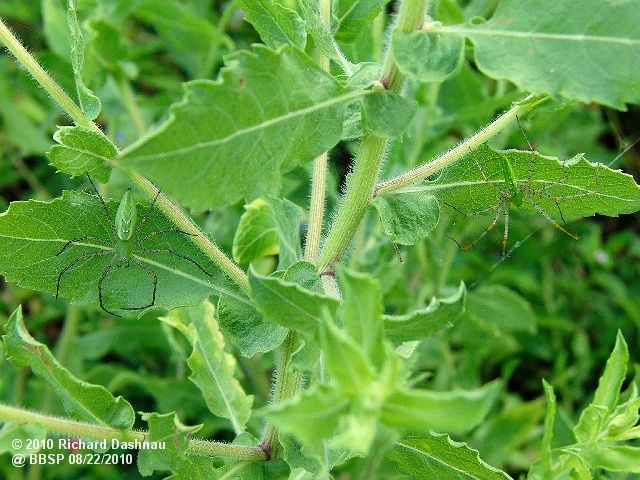 -----------
-----------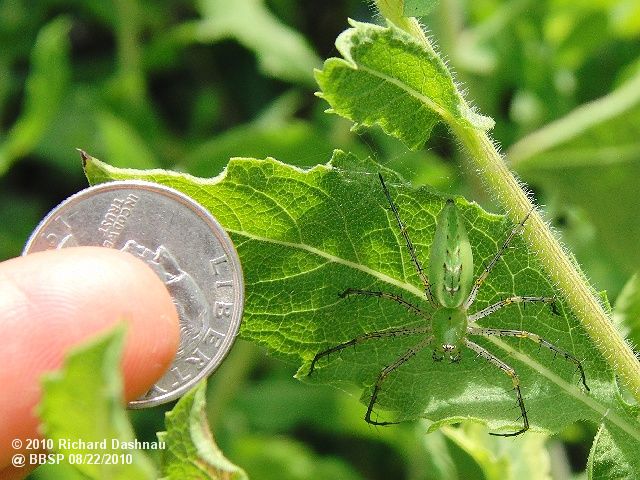 ------
------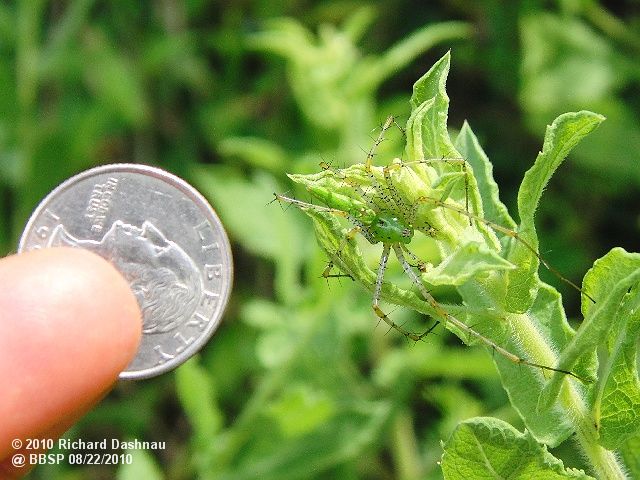 ----
---- MALE AND FEMALE ON OPPOSITE LEAVES FEMALE WITH QUARTER MALE WITH QUARTER
Go back to my home page, Welcome to rickubis.com
Go back to the RICKUBISCAM page.
This started as a place to collect spider pictures
as I moved them from the RICKUBISCAM. As I got more pictures of
spiders, I started putting them here. Over time, I got
enough of them to be able to split off separate pages. The links
to the other pages are above. To get the most information, it
might be best to browse them in order. I
recommend a book I've bought to anyone who is interested in
spiders (maybe I'd recommmend it to people who aren't
interested in spiders. The title is:
Biology of Spiders, by Rainer F. Foelix, published in 1996. This
has a lot of information on spider biology. It is not an
identification guide, but is filled with detail on how
spiders do what they do(Since they're "spiders" do they "spide"?
Is what spiders do called "spiding"? Probably not. It's just
another mystery of the English language.).
In fact, if you read the book, I'd be surprised if you didn't
develop an interest in spiders.
August
22 and 29, 2010
While
I was looking through the gardens at the Nature Center (looking for
Praying Mantids), I discovered a pair of large Green Lynx Spiders
(Peucetia Viridans).
I took some pictures of them and then continued my mantis search.
Male spiders often have the ends of the pedipalps (the "short" pair
legs in front of the jaws) enlarged, so I think one was
female and one was male. The top set of pictures is from August 22nd.
- -----------
----------- ------
------ ----
----
MALE AND FEMALE ON OPPOSITE
LEAVES
FEMALE WITH
QUARTER
MALE
WITH QUARTER
The next week, I found them again.The pictures below
are from August 29th. Then, someone else told me where another one
in the next garden had caught a bee. So, more pictures. As I
mention on in an older post on this
page these spiders have been observed "spraying their venom
from their fangs" when the spider is stressed--such as by pulling
a leg with tweezers. The
Green Lynx will turn towards the annoyance and spray. I'm curious
about how this "spray" works. Does it increase fluid
pressure until the venom is forced out from the fang openings?
What??
I'll repeat the link I put on the other page here--to one report.
Click
here
for the pdf. I've also found another reference
(with a few picture showing spray patterns on glass) on page 27 in
this book:
Secret Weapons--Defenses of Insects, Spiders, Scorpions,
and Other Many Legged Creatures by Eisner, Eisner, and Siegler
(C)2005 I'll see if I can investigate this further by
watching the spiders.
As I posted somewhere else recently--if some giant pulled
one of my legs, then I'd spray, too....just not from my
fangs.
--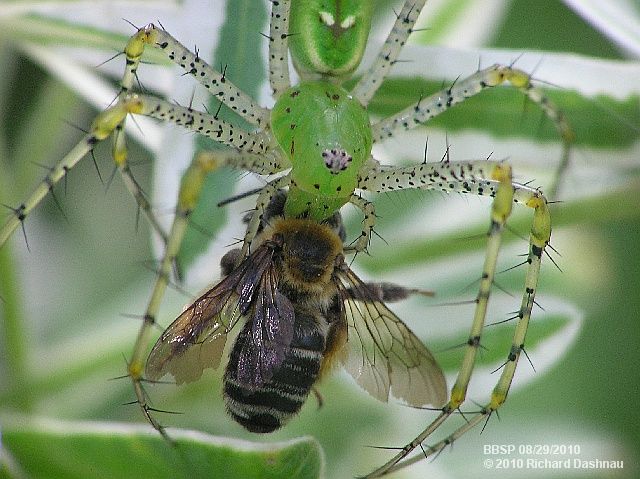 --
--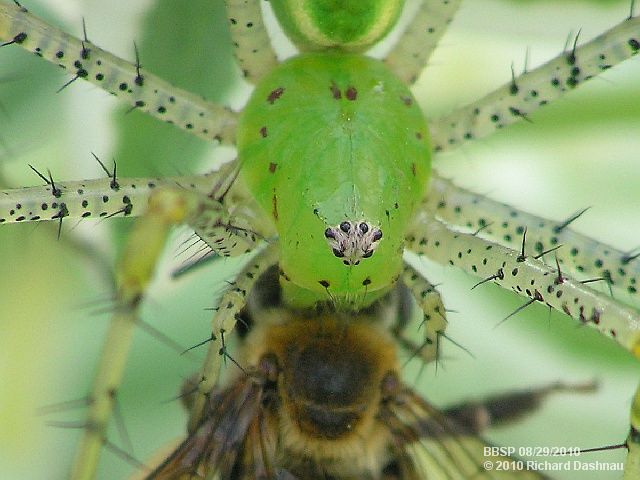 -
-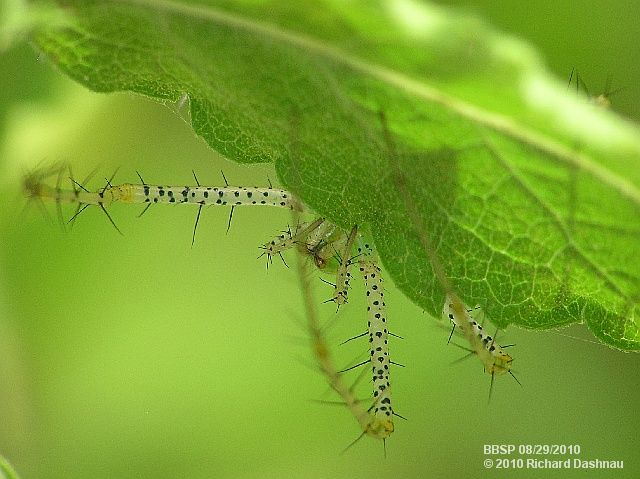 -
-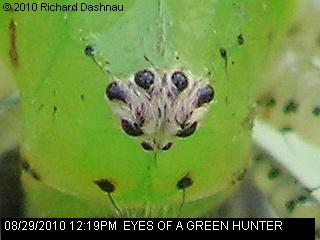 -
-
GREEN LYNX WITH CAPTURED
BEE
GREEN LYNX WITH CAPTURED BEE
CLOSER GREEN LYNX PEEKING
UNDER A LEAF
October 06, 2002The
image below left (NOT A GOOD DAY. below) is just our tarantula in
the Nature Center enjoying a meal. I guess there are a few lessons
here: ONE, that no matter how bad
your day is, it would be far worse if you were being eaten by a
spider and TWO, that a meal can be a cause of great satisfaction
*and* great dissatisfaction, depending on which side of the jaws
you're on.
------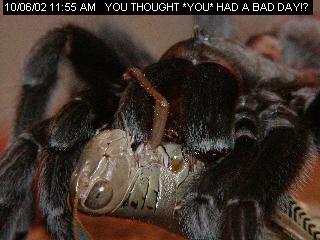 - -------------------------------------
- -------------------------------------
NOT A GOOD DAY?
September 08, 2002The
picture below(GREEN LYNX) shows a "Green Lynx Spider" (Peucetia
viridens), with a quarter. For those who haven't figured it out,
the various coinage that appears in my nature
pictures is for scale, and NOT because I have to pay any of these
animals to pose, and not because they need the money.
The Green Lynx Spider doesn't
make a web to live in (like the various orb weavers do), but
instead it likes to skulk about in vegetation, pouncing out on any
prey that might happen by. As I was searching the
internet for information on this spider, I discovered an
interesting fact. These spiders spit poison! (Oh, no...not another
venom-spitting arthropod!) Click here
to see a .pdf file that gives this information. The
spitting in this species appears to be a defensive behavior. There
is another spider that spits a mixture of poison and sticky glue
to catch prey (family Scytodidae,genus Scytodes), by actually
squeezing its
prosoma (cephalothorax) using internal muscle contraction and
squirting out this mixture in a zigzag pattern that sticks its
prey to the ground and paralyzes it. However, the Green Lynx
spider apparently only
spits venom when attacked. (Note--In
studies
that I've found since I wrote this, and direct communication with
Dr. R.B. Suter; there is increasing evidence that there is no
toxic component in the "spit" of
scytodes. It
has
been shown that the spit can actually contract so that besides
gluing down the target organism there is also a tightening effect.
This could cause the limbs of the prey to contract and give the
illusion that the prey was "curling up" and dying. Look for these
studies online: Spitting
performance parameters and their biomechanical implications in
the spitting spider, Scytodes thoracica. Suter RB,
Stratton GE and Clements R, Li D. 2005. Regulation and
non-toxicity of the spit from the pale spitting spider Scytodes
pallida R. Dashnau 09/02/2010 Try this link for
the first study.
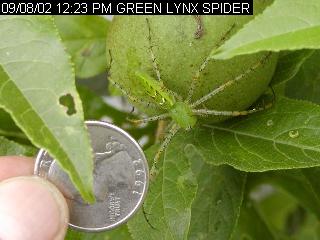 -
-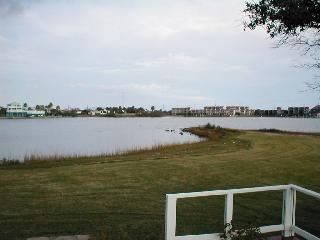 -
-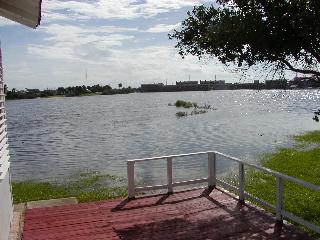 --
--
GREEN LYNX
THE USUAL
LEVEL
MORNING AFTER FAY
Some of you may be aware
that tropical storm Fay briefly threatened my home. While there
was some flooding of nearby areas, it was not as bad as the damage
that Allison wrought last year. A friend of
mine happened to live in Galveston, though, and she got to watch
as the water steadily got higher Friday night. I went out
there Saturday, and the water was still a bit higher than usual.
The two pictures above
show the change. THE USUAL LEVEL was taken last November.
The MORNING AFTER FAY was taken at about 10:30 am Saturday, Sept.
7th. The rest of the day was excellent.
September 4, 2002 Last
Monday, Labor Day, I was at the park, doing park things, when John
drove up in one of the gators. He told me about a large spider
that he saw inside one of the water stations on the
Spillway trail. Not long after that, Herb mentioned the same
spider.
So, I stopped by this water station, and looked
inside. I did't see any spider, and started to stick my head
in, but then decided I might not like a large, annoyed
spider of indeterminate species jumping down
onto the back of my neck. So, I carefully looked again, and then I
found it. With a little maneuvering I was able to get some
pictures. One is below.
----------------------------------------------------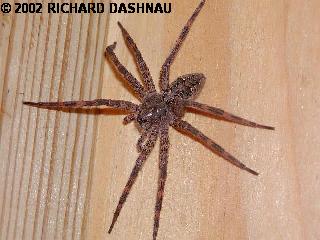
I suspected that this was another spider of the Dolomedes genus. So, I decided to ask the "high priestess of Dolomedes", Ms. Kelly Kissane.
Here is part of my email to her:
....Here's
my story. Yesterday, two people told me about this "big spider"
that was hiding in our little water station.
They
knew I like to take pictures of them. So, I looked, and found it
hiding up against the ceiling. The picture with it
against
the end of the board shows where I found it. That wood is about
1-3/8 inches to a side. I blew on the spider,
and
it moved onto the wall, allowing me to get the other shot.
I'm reluctant to bother the animals too much, so that's
all
I did. I was lucky to get the shots I did, considering I had to
reach inside the box while
holding
the camera.
Am
I right in guessing that this is a Dolomedes Tenebrosus? The body
shape and the "frowning face" eye
arrangement
seems similar to our other friend's (D. Albineus). Also, that
pattern on the rear segment
(abdomen/opisthosoma)
seems like what I can see in the guidebook. Since I think it's a
Dolomedes, I figured
you'd
be the person to ask....
And here is her answer:
Rick,
That's
definitely Dolomedes tenebrosus - a large female. The males
are less than 1/2 that size
(sometimes
they're 1/4 the size of the female)....
Kelly
So, there's the story. I've been fortunate (some may not agree) to be able to see two different spiders in the genus Dolomedes.
August 18, 2002
I went to check on my Alligator Gar's head. This is the same large
gar that I've mentioned before. I'm trying once again to clear the
remaining decaying matter off of it. This time, I'm using a
steel mesh cage that I made, and I placed this on an ant's
nest. I'd picked up the head, and inspected it, and when I
set it back down, I saw a large spider on top of the skull. At
this point, I think it's some type
of wolf spider, but I'll see if I can identify it. Both pictures
show the spider standing on the gar's skull. (see Wolf1 and Wolf2,
below. Wolf2 is pictured with a quarter.)
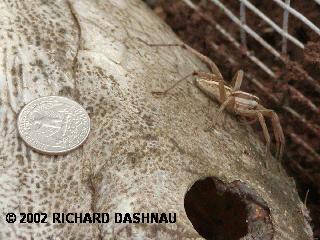
WOLF
1
WOLF
2
According to my Audubon
Society Field Guide to North American Insects and Spiders, this is
a wolf spider. Specifically, it's known as a Rabid Wolf Spider
(isn't that a nice name?), Lycosa Rabida. When
I searched the internet, I found that this species has been
renamed Rabidosa Rabida. At this point, I don't know much
about spider classification, and for now I'm putting the Latin
names for animals on my
pages for both readers' and my education. It will be a long time
before I can remember all these names. The key identification
point seems to be the two lengthwise dark stripes on the front
section
(cephalothorax, sometimes called the "prosoma" on spiders), and
the dark stripe between two pale stripes on the abdomen (also
called the "opisthosoma" on spiders). The two main body
parts are joined
by a thin joint called the "pedicel" (Source for body part names:
Biology of Spiders-2nd edition, by Rainer F. Foelix.) Click
the image below to see these parts labeled on a real spider.
-------------------------------------------------------------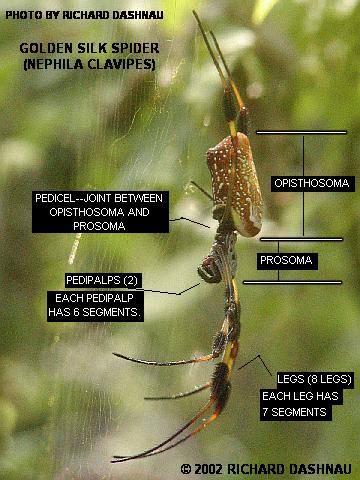
July 21-20, 2002
I guess we're moving into our summer weather, although it hasn't
broken 100 degrees F yet. The number of visitors to the park has
lessened somewhat. Today, July 21(Sunday), I took a
few more pictures of some of our Golden Silk Spiders. This picture
shows a pretty big one (see HOW BIG?, above). I took two
more pictures of this one, with different objects to give a better
idea of the
size. (See CATCH MY NAME, and WITH A QUARTER above). These spiders
are usually harmless to humans, but it still gave me some
heebie-jeebies to look through the camera zoomed in as I
moved
my hand closer to the spider. I'll
mention here that Ms. Kissane, in our early communication, pointed
out the there is a very poisonous, and aggressive spider from
South America also known as "Banana
Spider", because it has turned up in shipments of bananas here in
the U.S. Please don't start killing the spiders I've shown here
under the impression that these "Banana Spiders" are the same.
They aren't.
If you'd like to know more about the park follow these links:
Brazos Bend State Park The main page.
Brazos Bend State Park Volunteer's Page The volunteer's main page.
Click on
this image 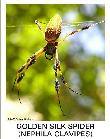 to see a flv
video movie (942kb) of a series of 9 11 x 14 posters I'm working
on.
to see a flv
video movie (942kb) of a series of 9 11 x 14 posters I'm working
on.
If you'd like to know
more about spiders (besides what I have on my pages), then go visit the:
THE ARACHNOLOGY HOME
PAGE
The Arachnological Hub
of the World Wide Web
There, you will find
about 2000 more links to information on spiders on the internet.
The webmaster there
was kind enough to place a link to this page there. The link to
me is on this
page.
Go
back to my home page, Welcome to
rickubis.com
Go
back
to the RICKUBISCAM
page.
Go
back
to the See the
World page.